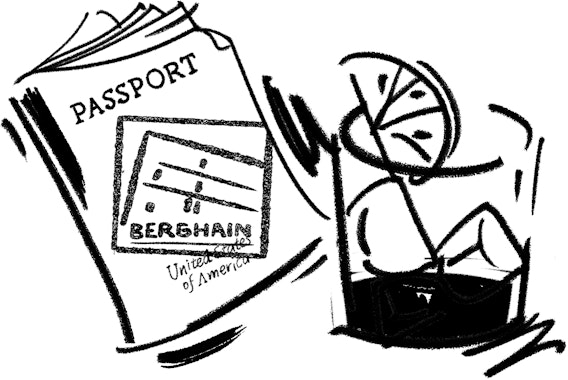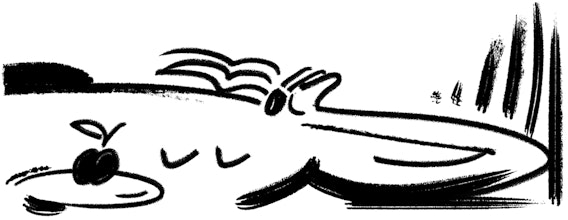Learning to live life by the rule book.
Perhaps it’s something to do with the colours, or the shapes. Red, yellow, blue; square, circle, triangle: the Highway Code is made of primary school stuff. Even the typeface has an ‘early reader’ feel to it, round, black and clear. Graphic designers came up with it in the late 1950s, tasked to improve Britain’s traffic signs by the Department of Transport. They called the font ‘Transport’.
I’ve got some favourite road signs – who doesn’t – usually the red-rimmed triangular warnings which have a little more narrative heft than your average circular speed limit. ‘Falling or fallen rocks’ is arguably as close to art as the Highway Code ever finds itself, unusual in its depiction of movement, the rocks jagged and uneven, chaos tumbling from a mountain. The rare ‘wild horses or ponies’ is lovely, too: the horse fleeing in a spray of running legs. (The cow in ‘cattle’ is allowed none of the same freedom but stands still, with a certain majesty, sure, but also as if in surrender to the oncoming traffic.) Best of all must be ‘quayside or river bank’. You’d think they could have drawn a simple image of a car near water. But no, the car tips at a violent angle off the edge of a high bank, its nose pointing down towards the rolling waves below. It is a picture of death.
If only they were all so memorable. When I was learning to drive, which was a long, erratic and expensive project that spanned several years, I struggled to learn the signs. And the rules. When the Highway Code was first introduced in 1931, it was 21 pages long. Now, the Code reaches 235 pages and lists 307 rules written in a language which contains its own code, the code of the code. In the introduction, the authors – unnamed but plural (an authoritative ‘we’) – declare that some of the rules are legal requirements. ‘Such rules,’ they write, ‘are identified by the use of the words MUST/MUST NOT.’ (The musts and must nots, which appear 270 times, are always in uppercase bold type). For example: ‘You MUST NOT take a horse onto a pavement.’ (Rule 54). It makes for a hectoring read, but you can’t fault them on clarity.
Soften to it, though, and you find a kind of beauty. The ‘hierarchy of road users,’ rule H1, precedes all the other rules because it expresses the code’s underpinning philosophy. Those in charge of the most dangerous vehicles ‘bear the greatest responsibility to take care and reduce the danger they pose to others.’ Or, to put it another way, always give way to those more vulnerable than you, a rule that society wouldn’t do badly to adopt, if only we could turn the world on its head.
Unsurprisingly, between the ages of 17 and 22 I wasn’t at my most receptive to a book of 307 rules. My first attempt at the theory test, shortly after university, went badly. I had an English degree: the worst training. Jazzed on self-importance and seven types of ambiguity, I seemed to be incapable of answering questions. I remember one, about what you should do if you arrive at the scene of an accident where people are trapped inside a wrecked car. Call 999, sure. But after that. Drive away? Keep them warm? Remove pieces of wreckage stuck to their bodies? I wasn’t a psychopath, I wasn’t going to hot-tail it out of there. But what do you do? They hadn’t given me enough information, I felt. The wording was, well, yes, it was ambiguous actually. I opted to remove the pieces of wreckage, which turned out to be very much the wrong answer. A friend suggested afterwards that I’d probably skinned the poor fuckers alive.
So yes, I failed. And then I failed again, and again. At least three times, I think. I kept refusing to learn the code properly, bored by its instructional tone and insistence on facts. I kept thinking I could wing it. I suspect I thought I was above it. Luckily, both for other road users and my personality, you can’t wing things that are either right or wrong. After one failure, I remember going to the front desk of the testing centre to get my result. The woman looked at me with pity, then gave me directions out of the building as though I had suddenly lost a great number of my faculties. She spoke slowly and kindly, and I was grateful and ashamed.
Eventually, I gave in, buckled down, learnt the stuff and passed, just like everyone else. Still, there wasn’t much internalisation. Driving in my twenties, which meant borrowing my mum’s car, was more of an exercise in catastrophe. I had a couple of minor crashes, like the one when I drove extremely slowly into a stationary car while reading a map. (A car on the other side of London from my home, that, in the kind of coincidence that is too awkward to digest, turned out to belong to someone I went out with for three weeks when I was 15.) I wasn’t used to learning something that I would have to use in real life, so it wasn’t long before I fell foul of the rules. I couldn’t quite believe my first speeding fine. What, they actually mean it?
Soon enough, the speed awareness course beckoned. It comes for us all in the end. But, get this, I loved it. As always with learning, it was all about the teachers. Two guys, jacketless, sharp as pins. They knew what they were dealing with: a bunch of people pissed off at being held captive in a hotel conference room in an outer corner of London. People who wanted to get through the morning, then drive off at speed with their newly laundered licence. They were expert wranglers of cynicism, these men. They laughed at us, and scared us, and made something very clear to me: that the Highway Code wasn’t a guide, or a suggestion. It wasn’t open to interpretation. The 307 rules were actual rules.
I don’t know if it was a time-of-life thing, mid-thirties, having kids. Perhaps I was just finally ready to have my speed awareness moment. (I know other people who’ve had a quasi-religious conversion experience on the course.) Anyway, I felt something turn. The rules accrued meaning. Rules were a larger part of my life now anyway. I was apparently supposed to be establishing them myself, laying down the laws in the land of my home, policing the consumption of sugar and Netflix. No part of me has ever wanted to enforce anything, but have a kid and you find yourself helplessly involved in a strange tyranny. It’s profoundly uncomfortable, unless you like that sort of thing.
For some people, authors of the Highway Code included, rule-making seems to come naturally. I suspect they’re the kind of people who have a robust internal structure, who know what to do next, and how to do it. But if you’re not one of those people, if parenting instead presents itself to you as a limitless opportunity to fuck things up for people beyond yourself, well, then all you want is someone to tell you what to do. It’s why the idea of the nanny state being a bad thing always made me laugh: what if you want a nanny? In the form of the Highway Code, the nanny was right there on the side of the road, shouting very clear instructions. I was so happy to see her.
I didn’t have a car for a few years but not long ago I bought a 13-year-old grey one which sometimes, at random, maybe once a month, gets stuck in neutral when you stop at traffic lights. Not ideal, really. As the lights change, the cars behind you start hooting and you can’t move. The constant possibility of this situation means that I drive around in a state of high, panicked alert. Maybe it’s that, or because my kids are bigger now and there’s often one in the front seat, watching me drive with the kind of cool, critical gaze that children reserve for their parents. Whatever it is, my awareness of the Code has never been greater. I see the signs, I read the rules, and I respect them. More than that: they induce in me a deep fondness, something close to relaxation, even gratitude. You MUST secure your load. You MUST NOT drive under the influence of drugs. You MUST wear a seat belt. There is no room for argument here, no ambiguity. I am not doing the telling; I am being told. It’s like an acceptable form of fundamentalism: a code gives you something to hold on to, something to live by. Don’t fall into the river. Watch out for those rocks. Give way.



